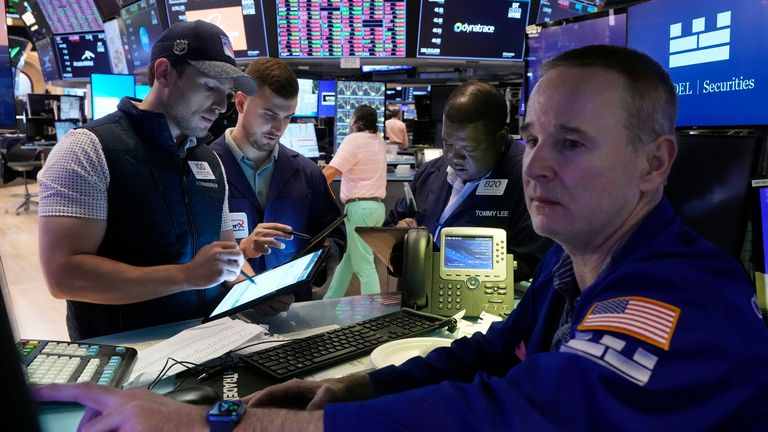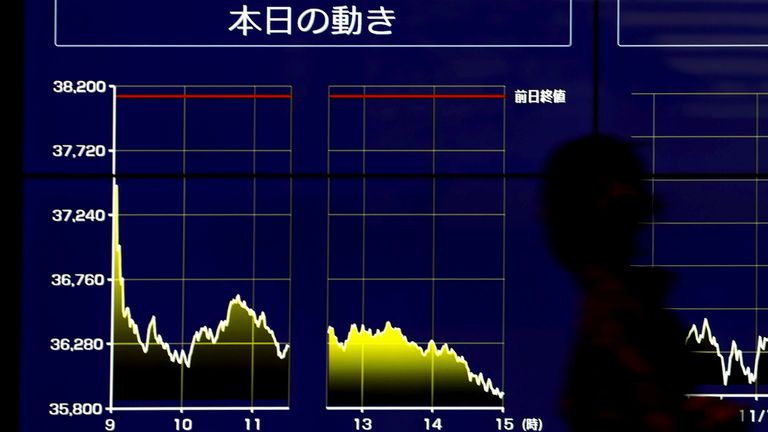Nasty summer sell-off in stock markets set to roll on
A very nasty summer sell-off has been under way now in stock markets around the world for the last 48 hours – and nervous investors got another reason to carry on selling on Friday.
The US non-farm payroll figures – essentially a measure of how many jobs were added to the US economy last month and probably the single most-watched piece of economic data in financial markets – came in much lower than expected for July.
Some 114,000 jobs were created in the US economy during the month. That was significantly lower than the 175,000 jobs that Wall Street had expected to see created.
Money latest – follow for updates
It was the weakest figure since December last year and the second weakest since March 2020 – when the pandemic was just taking off in the West.
The June number was also revised lower from the previously healthy-looking 206,000 to 179,000. The figures, when taken alongside the number of people entering the workforce, mean that the unemployment rate in the US in July rose to 4.3%.
That again was worse than the 4.1% pencilled in by Wall Street. And they have intensified fears that the world’s biggest economy may be heading for a recession.
Those fears had already started to swirl when, on Wednesday evening, the US Federal Reserve declined to cut interest rates from the 5.25%-5.5% range at which they have been since July last year – only for some figures the following day pointing to a contraction in US manufacturing activity during July.
That had already put the skids under US equities even before the jobs data. All of the main US stock indices fell on Thursday – with the S&P 500, the most important index, falling by 2.5% and the Dow Jones Industrial Average declining by 1.9%. The tech-heavy Nasdaq slumped by 3.3% and the Russell 2000, the main index of smaller US companies, slid by 3%.
Those falls were added to on Friday afternoon – setting the S&P 500 and the Nasdaq on course for a third consecutive weekly fall.
The index, which was also weighed down by some mixed trading updates from the big tech companies, is now at a level last seen in May and is officially in ‘correction’ territory, in other words, it has fallen by more than 10% from its most recent peak in July.
There were even more violent declines in some individual stocks with Snap, the owner of Snapchat, down 30% at one point and the chipmaking giant Intel down 28%.
Shares of the British chip designer Arm Holdings, which is also listed on Nasdaq, fell a further 6% and has lost getting on for a quarter of its stock market value this week. Amazon, one of the tech heavyweights whose trading updates disappointed Wall Street overnight, fell by 12%.
Other asset classes are also falling. The price of oil – demand for which would be expected to fall in the event of a US recession – is on course to complete a fourth consecutive weekly reverse with a barrel of Brent Crude this afternoon hitting $77.70, a level last seen un the first week of June.
To the upside, the price of gold, a traditional safe haven for investors, is back at close to the all-time high of $2483.60 that it hit on 17 July.
And US Treasuries – or US government IOUs – have also risen sharply. The yield, which falls when the price rises, on 2-year US Treasuries, which closely track interest rates, fell below 4% for the first time since May last year while the yield on 10-year Treasuries fell at one point to 3.79%, a level last seen in December last year.
Market commentators and economists now fully expect the Fed to cut interest rates next month.
Seema Shah, chief global strategist at fund manager Principal Asset Management, said: “Oh dear, has the Fed made a policy mistake? The labour market’s slowdown is now materialising with more clarity.
“Job gains have dropped below the 150,000 threshold that would be considered consistent with a solid economy. A September rate cut is in the bag and the Fed will be hoping that they haven’t, once again, been too slow to act.”
Michael Brown, market analyst at the trading platform Pepperstone, added: “The July US jobs report pointed to a continued cooling in labour market conditions.
“There is little in this report that is likely to dissuade the Federal reserve open markets committee from delivering this cycle’s first [interest rate] cut at the next meeting in September, as was hinted at in this week’s statement.”
European stocks, meanwhile, had already fallen on Thursday and continued those declines on Friday. The FTSE-100 is down by 2.15% since Wednesday evening, a slighter fall than some of its peers on continental Europe, which have a greater exposure to tech stocks.
The CAC-40 in Paris is off by 3.1% in the last two sessions and the DAX in Germany down by 4.1%. The MIB in Italy is down by 5.3% in the same period and the AEX in the Netherlands, an index dominated by ASML – the world’s largest maker of equipment used to manufacture chips – is down by 3.9%.
Meanwhile, in the Asia Pacific region, Japanese stocks have seen a truly aggressive wave of selling.
This was due largely to a sharp rally in the yen against the US dollar following a surprise interest rate rise on Wednesday from the Bank of Japan.
The weakness in the yen, which hit a 38-year low against the dollar in June this year, has been a major driver of gains for Japanese stocks this year and the currency’s rally has sent the market slamming into reverse. The Nikkei 225 index, which contains Japan’s top blue-chip companies, had already fallen on Thursday and on Friday declined by a further 5.8% in its biggest one-day fall since March 2020.
The Nikkei, which earlier this year hit an all-time high, is now down by 12% since 12 July.
Meanwhile the Topix, which is a broader index of Japanese stocks, fell by 6.2% in its worst one-day fall since 2016.
Read more from Sky News:
Mixed results for tech giants
What the interest rate cut means
The interesting thing about this latest sell-off is that, during recent years when central banks like the Federal Reserve and the Bank of England kept their policy rates at ultra-low levels, bad news for the economy was taken as good news for markets on the basis that it would persuade central banks to hold rates lower for longer.
That all changed when, in December 2021, the Bank became the first major central bank around the world to begin raising interest rates and was followed soon after by the Fed.
Now, with the ‘normalisation’ of interest rates under way for more than two years, bad news for the economy is back to being treated as bad news for the markets.
Be the first to get Breaking News
Install the Sky News app for free









